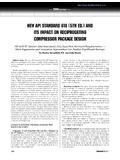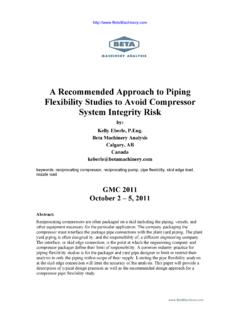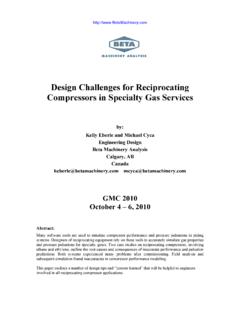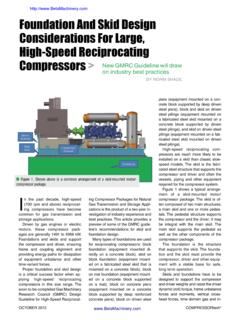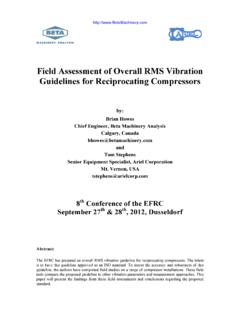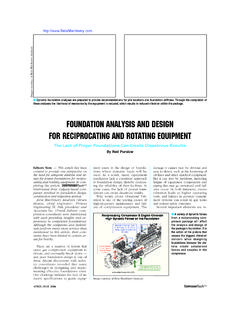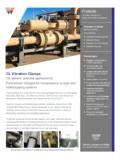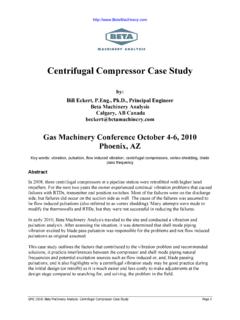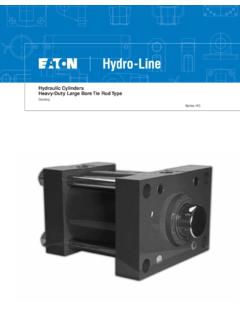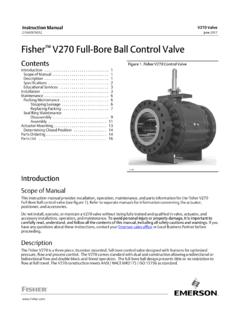Transcription of Integrity Evaluation of Small Bore Connections …
1 1 Integrity Evaluation of Small Bore Connections (Branch Connections ) by: Chris B. Harper, Principal Engineer Beta Machinery Analysis Calgary, Canada 9th Conference of the EFRC September 10th - 12th, 2014, Vienna Abstract: Evidence shows that vibration induced failure of Small bore Connections (SBC), also called branch Connections or Small bore piping, is an ongoing challenge during both the design phase and field testing. Failure of Small bore piping on reciprocating compressor systems is a common industry problem. In fact, many industry experts believe that these failures represent the highest Integrity risk and more attention is needed during the design and when conducting vibration surveys. The Energy Institute and Gas Machinery Research Council provide recommendations and screening guidelines for the Evaluation of SBCs in vibratory service.
2 There are other screening guidelines available for vibration-induced fatigue failure that contain stress calculations. These guidelines and approaches are useful for screening SBCs but they are not as useful for advanced analysis and field vibration surveys. A more comprehensive approach is needed to help industry with this question, what to do if a SBC fails the EI or GMRC guideline? This technical paper will: - Summarize existing approaches, recommendations and guidelines for SBC; - Identify gaps and challenges in applying the existing approaches; - Recommend an approach to address these gaps, and proposed guidelines for new designs; and - Provide a proposed methodology for evaluating SBC vibration in the field.
3 SBC vibration guidelines are not currently included in the upcoming EFRC/ISO vibration guidelines. The results and findings from this paper could be a valuable input to addressing SBC Integrity risks in this ISO (or other) standards. 2 1. Introduction Small bore Connections (SBCs) are a major source of failure on piping systems but are infrequently evaluated during the design phase of a project or during the field commissioning phase. Piping vibration and fatigue can account for up to 20% of hydrocarbon releases, and a large portion of those are due to failure of Small bore Connections [1]. Hydrocarbon emissions can lead to fire, explosions, injuries, property and environmental damage.
4 The following paper outlines different approaches, standards and guidelines that relate to SBC, both in the design phase, and during field testing. To address the existing industry challenges, a practical approach is provided to improve the design and Integrity of SBCs. The following recommendations are based on years of field testing, research, involvement with API 688/618 and GMRC committees, and involvement with a number of original equipment manufacturers (OEMs) of rotating machinery, packagers of rotating machinery, and end-users/owners. While the following examples and discussion focus on reciprocating compressor applications, the approaches and recommendations apply to SBC located near reciprocating pumps, as well as centrifugal machines, or nearby piping system.
5 Figure 1. Small bore connection definition chart Definitions A Small bore connection (SBC) is defined as a branched connection on mainline piping that is NPS 2 (DN 50) and smaller, including Connections that have a branch pipe to mainline pipe ratio ( branch ratio ) of less than 10%, and excluding Connections that have a branch ratio greater than 25%. Note that mainline piping could also describe equipment like a vessel or cooler to which the SBC is attached. A chart showing the SBC size definition is shown in Figure 1 above. Small bore piping (SBP) is defined as the piping that is attached to the Small bore connection, extending until the effect of the mainline piping vibration is negligible (typically, the nearest support or brace).
6 Refer to Figure 2 for an illustration. The Small bore piping that is of most concern is that which contains production fluid at operating pressure. Auxiliary lines, like pneumatic air, crankcase vents, etc., are not as critical. Figure 2. Small bore and mainline piping defintions Acronyms 1D One dimensional ANSI American National Standards Institute DN Diam tre nominal EDI Engineering Dynamics Incorporated EI Energy Institute EPC Engineering, procurement and construction ESD Emergency shutdown FEA Finite element analysis GMRC Gas Machinery Research Council LOF Likelihood of failure MNF Mechanical natural frequency ODS Operating deflected shape PSV Pressure safety (or relief) valve RFLWN Raised face long weld neck (flanges) SBC Small bore connection SBP Small bore piping 3 2.
7 Challenges and Gaps with Current Practices A large number of compressor/pump systems are fabricated and installed without a detailed design of SBP weight, geometry, or location, including the SBCs located off-skid or away from the compressor or pump frame. It is rare that a specification will require a SBP audit at the design stage or during field commissioning. The lack of detailed analysis is due to these reasons: The design and layout of Small bore piping is not known during the design stage. It is either shop-run or field-run, and there may not be drawings available. Even if the drawings are available at the design stage, the mass of non-standard components may be unknown because they have not been selected by the purchasing department, or they will be specified by the EPC.
8 SBP mechanical natural frequencies (MNFs) are more sensitive to uncertainties in concentrated masses because they represent a higher percentage of the total mass of the SBP. Field audits may not be specified because of confusion about what piping is classified as SBP, and what vibration guidelines should be used. A thorough Evaluation of Small bore piping requires a shop test or a field Evaluation . Different companies (and departments within companies) are involved at different stages, like front-end engineers, design, procurement, testing, commissioning, and operations. Therefore, a complete SBC Evaluation involves coordination with many companies and departments.
9 These practical issues and limitations at the design stage, and during compressor start-up, are significant barriers to resolving SBC Integrity risks. 3. Current Design Evaluation Methodology There are various articles and guidelines on suggested approaches to review SBCs during the design stage of a project. This section briefly outlines these approaches and summarizes their advantages and disadvantages. At the design stage, there are basically two Evaluation methodologies: robustness and mechanical natural frequency (MNF). The robustness of a SBC can be judged based on characteristics like piping diameter, thickness, flange rating, and location on the mainline piping.
10 These can be compared to the characteristics of well-designed SBC. This methodology is limited to SBCs that fall into certain predefined groups. Also, there is some risk remaining because of the statistical nature of this method. The SBP MNF can be estimated (using empirical calculations or finite element analysis) and compared to industry guidelines. Currently, there is not industry-wide consensus on the MNF guidelines to use. Best Practices Many owners, EPCs, and machinery packagers have best practices on SBC design. These include guidelines on what type of connection to use ( , weldolet, sweepolet, or welded tee), welding procedures on SBCs, whether bracing is required, where Small bore Connections should be located, etc.
